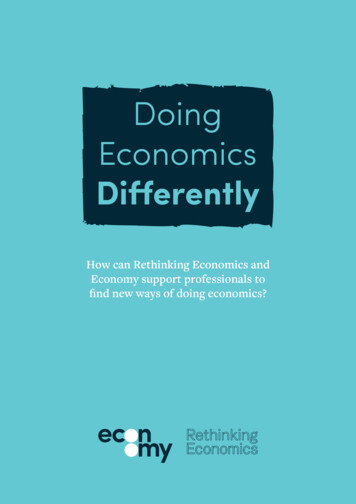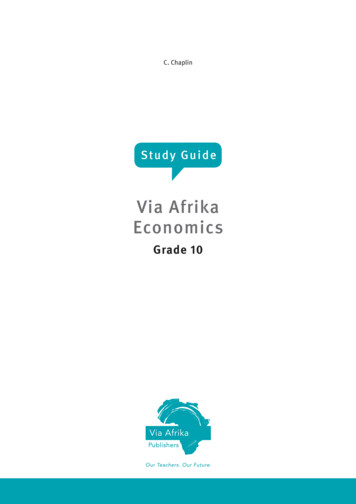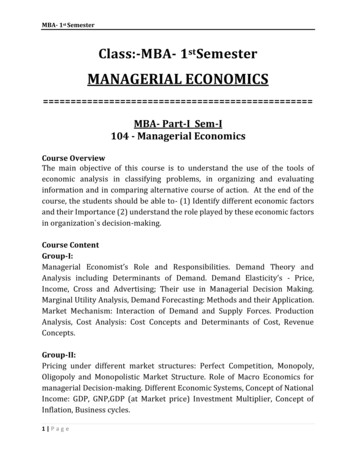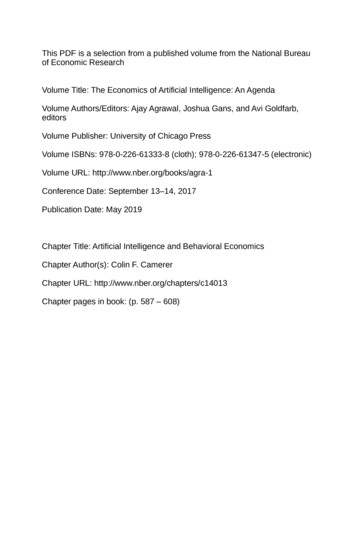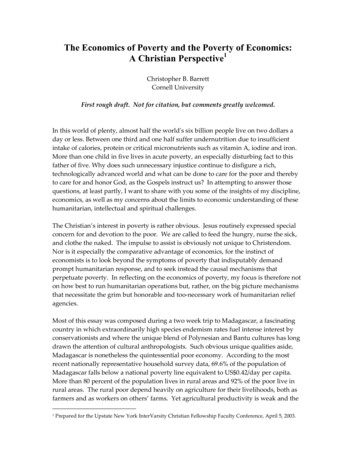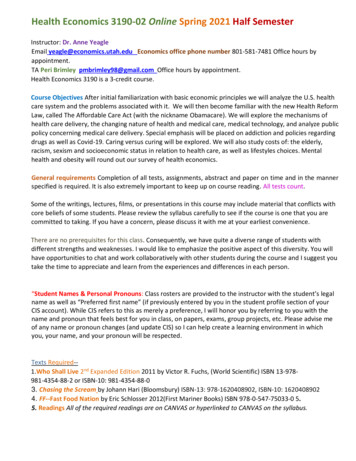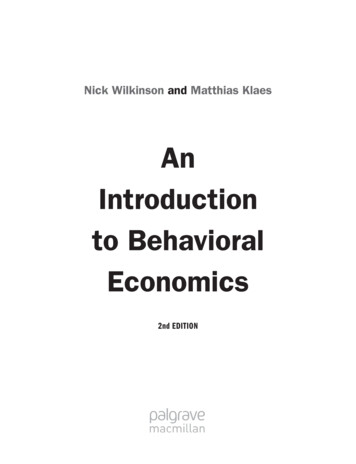
Transcription
Nick Wilkinson and Matthias KlaesAnIntroductionto BehavioralEconomics2nd EDITION
Nick Wilkinson & Matthias Klaes 2012All rights reserved. No reproduction, copy or transmission of thispublication may be made without written permission.No portion of this publication may be reproduced, copied or transmittedsave with written permission or in accordance with the provisions of theCopyright, Designs and Patents Act 1988, or under the terms of any licencepermitting limited copying issued by the Copyright Licensing Agency,Saffron House, 6-10 Kirby Street, London EC1N 8TS.Any person who does any unauthorized act in relation to this publicationmay be liable to criminal prosecution and civil claims for damages.The authors have asserted their rights to be identified as the authors of this workin accordance with the Copyright, Designs and Patents Act 1988.First published 2012 byPALGRAVE MACMILLANPalgrave Macmillan in the UK is an imprint of Macmillan Publishers Limited,registered in England, company number 785998, of Houndmills, Basingstoke,Hampshire RG21 6XS.Palgrave Macmillan in the US is a division of St Martin’s Press LLC,175 Fifth Avenue, New York, NY 10010.Palgrave Macmillan is the global academic imprint of the above companiesand has companies and representatives throughout the world.Palgrave and Macmillan are registered trademarks in the United States,the United Kingdom, Europe and other countriesISBN-13: 978-0-230-29146-1This book is printed on paper suitable for recycling and made from fullymanaged and sustained forest sources. Logging, pulping and manufacturingprocesses are expected to conform to the environmental regulations of thecountry of origin.A catalogue record for this book is available from the British Library.A catalog record for this book is available from the Library of Congress.1021920819718617516Printed and bound in China415314213112
Brief ContentsDetailed Table of ContentsivList of FiguresviiiList of TablesixPrefacexAcknowledgmentsxiiiPART I INTRODUCTIONCHAPTER 1 Nature of Behavioral EconomicsCHAPTER 2 Methodology128PART II FOUNDATIONSCHAPTER 3 Values, Preferences and Choices62CHAPTER 4 Beliefs, Heuristics and Biases115CHAPTER 5 Decision-making under Risk and Uncertainty146CHAPTER 6 Mental Accounting218PART III INTERTEMPORAL CHOICECHAPTER 7 The Discounted Utility Model260CHAPTER 8 Alternative Intertemporal Choice Models283PART IV STRATEGIC INTERACTIONCHAPTER 9 Behavioral Game Theory334CHAPTER 10 Social Preferences391PART V CONCLUSIONCHAPTER 11 Behavioral Economics: Summary and Outlook459Bibliography504Index559iii
Detailed Table of ContentsList of FiguresviiiList of TablesixPrefacexAcknowledgmentsxiiiPART I INTRODUCTIONCHAPTER 1 Nature of Behavioral Economics1.11.21.31.41.51.61.7Behavioral economics and the standard modelHistory and evolution of behavioral economicsRelationship with other disciplinesObjectives, scope and structureSummaryReview questionsApplicationsCase 1.1Loss aversion in monkeysCase 1.2Money illusionCase 1.3Altruism – the joy of giving2121519202020212326CHAPTER 2 lienceSummaryReview questionsApplicationsCase 2.1Do economists need brains?Case 2.2Riots in the UK2936455253535357PART II FOUNDATIONSCHAPTER 3 Values, Preferences and Choices3.13.23.33.43.53.6ivThe standard modelAxioms, assumptions and definitionsThe evolutionary biology of utilityBroadening rationalityTypes of utilityThe neuroscientific basis of utility646871748693
3.73.83.93.10Policy implicationsSummaryReview questionsApplicationsCase 3.1Drug addictionCase 3.2When abstention is better than moderate consumptionCase 3.3Environmental protectionCase 3.4The way the brain buys97102103104104105109109CHAPTER 4 Beliefs, Heuristics and Biases4.14.24.34.44.54.64.74.84.94.10The standard modelProbability estimationSelf-evaluation biasProjection biasMagical beliefsCauses of irrationalitySummaryReview questionsReview problemsApplicationsCase 4.1Fakes and honestyCase 4.2Trading on testosteroneCase 4.3Celebrity contagion and imitative R 5 Decision-making under Risk and 5.13BackgroundConventional approaches to modifying EUTProspect theoryReference pointsLoss-aversionShape of the utility functionDecision-weightingCriticisms of prospect theoryRecent theories and conclusionsSummaryReview questionsReview problemsApplicationsCase 5.1The endowment effectCase 5.2Insensitivity to bad income newsCase 5.3Loss-aversion in 15CHAPTER 6 Mental Accounting6.16.26.36.46.5Nature and components of mental accountingFraming and editingBudgeting and fungibilityChoice bracketing and dynamicsPolicy implications219220225233239v
6.66.76.8SummaryReview questionsApplicationsCase 6.1The equity premium puzzleCase 6.2Why you can’t find a cab on a rainy dayCase 6.3Consumer spending and housing wealth249250251251254257PART III INTERTEMPORAL CHOICECHAPTER 7 The Discounted Utility Model7.17.27.37.47.57.67.77.8IntroductionOrigins of the DUMFeatures of the DUMMethodologyAnomalies in the DUMSummaryReview questionsApplicationsCase 7.1Empirical estimates of discount rates261262265269273278278279279CHAPTER 8 Alternative Intertemporal Choice Models8.18.28.38.48.58.68.78.88.98.10Time preferenceTime inconsistent preferencesHyperbolic discountingModifying the instantaneous utility functionMore radical modelsEmpirical evidencePolicy implicationsSummaryReview questionsApplicationsCase 8.1Price plans for gym membershipsCase 8.2The savings problemCase 8.3The desire for rising consumption T IV STRATEGIC INTERACTIONCHAPTER 9 Behavioral Game Theory9.19.29.39.49.59.69.79.8viNature of behavioral game theoryEquilibriumMixed strategiesBargainingIterated 382
9.99.109.11Review questionsReview problemsApplicationsCase 9.1Penalty kicking in professional soccerCase 9.2Impasses in bargaining and self-serving biasCase 9.3Market entry in monopoly383384385385387388CHAPTER 10 Social 1010.11The standard modelThe nature of social preferencesFactors affecting social preferencesModeling social preferencesInequality-aversion modelsReciprocity modelsEmpirical evidencePolicy implicationsSummaryReview questionsApplicationsCase 10.1 The Wason TestCase 10.2 Public goods and free ridingCase 10.3 Sales force compensationCase 10.4 Too much virtue is a ART V CONCLUSIONCHAPTER 11 Behavioral Economics: Summary and Outlook11.111.211.311.411.511.611.711.811.9The agenda of behavioral economicsCriticisms of behavioral economicsMethodologyAre we really irrational?Welfare and happinessProblems in pursuing happinessPolicy implicationsFuture directions for behavioral economicsApplicationsCase 11.1 The effects of brain damage on decision-makingCase 11.2 Pursuing happinessCase 11.3 The bioeconomic causes of warCase 11.4 How to get children to eat ibliography504Index559vii
List of 0.610.711.1viiiIndifference curve mapIndifference curves and consumer equilibriumMoment utility of two colonoscopiesEquilibrium with face-value interpretationEquilibrium with weak diagnostic utilityEquilibrium with moderate diagnostic utilityEquilibrium with strong diagnostic utilityEUT utility functionRank-dependent probability weighting function with inverted S-shapeFriedman–Savage utility functionMarkowitz utility functionPT utility functionA typical PT weighting function (1979 version)A typical PT weighting function (1992 version)Empirical decision-weighting function for TK dataTAX modelShapes of discount functionsExponential discounting and consistent time preferencesHyperbolic discounting and inconsistent time preferencesTrend in household savings ratesExtensive form of ultimatum gameExtensive form of ultimatum game (Figure 9.1 repeated)Cournot response curvesCentipede gameDisappointment/retaliation gameCentipede game with reciprocityWason TestWason Test in terms of a social contractWason Test in terms of a switched social contractWason Test in terms of different perspectivesEvolution of cooperation in public goods gameThe Easterlin paradox (US, 54476
List of .6Decision-making in the standard modelPhenomena inconsistent with EUTThe Allais paradoxSame payoffs but different probabilities of winningThe Ellsberg paradoxEmpirical results related to weighting functionCombination and cancellationViolations of the combination principleEmpirical estimates of discount ratesRational consumers (exponential discounters}Naïve consumersPrisoner’s dilemmaDominant strategy equilibriumIterated dominant strategy equilibriumGame with no dominant strategyBattle of the sexesGame with no Nash equilibrium in pure strategiesMixed strategy equilibriumIterated dominance gameStag hunt gameInformation requirements for different learning theoriesReceiver’s success ratesPayoffs in a two-player gamePrisoner’s dilemmaStructure of payoffs in prisoner’s dilemmaPrisoner’s dilemma – monetary payoffsPrisoner’s dilemma – social utilitiesPareto efficiency and risk dominanceEffort costs for 43344351352353365375378384384403403426427435455ix
PrefaceThe first edition of this book started out by saying that there should not really needto be a book entitled ‘Behavioral Economics’. The same still applies some four yearslater. All economics is behavioral in the sense of examining how people choose toact and allocate resources in different types of situation. However, over the last threedecades the standard model of economic rationality, based largely on the assumptionof expected utility maximization, has come under increasing criticism from both outsideand inside the economics profession. The recent global financial crisis has exacerbatedthis situation. There are a large number of empirical anomalies that the standardmodel fails to explain.Behavioral economics attempts to answer many of these criticisms by taking abroader approach to studying economic phenomena. It is behavioral in the sense thatit combines the approaches of all the behavioral sciences, in particular economics,psychology, sociology and biology. This is currently not easy to do, since thesedifferent disciplines have traditionally adopted different and in many ways conflictingapproaches. It is the essential philosophy of this book that economics is ‘at its best’when it takes a cross-disciplinary approach.Yet, in spite of building criticisms and the considerable interest and debate in theprofession, there are still hardly any current texts available on behavioral economics.There are books on behavioral aspects of other disciplines, such as marketing, finance,and even managerial accounting; there are collections of papers on behavioraleconomics; and there are books on particular aspects of behavioral economics, such asbehavioral game theory. Thus there appears to be both high demand and low supplyfor a text in this area.Many undergraduate students are now starting to study aspects of behavioraleconomics. The book is particularly appropriate for students in the third or fourthyears of undergraduate study, or in a postgraduate program, once they have becomefamiliar with the standard economics curriculum, its assumptions and methods, andto some extent its limitations. For postgraduate students in particular the text shouldserve as a foundation of linked themes and materials, providing a jumping-off point forfurther reading of the original papers on which the book is based.The objectives of the text remain the same as with the first edition:1 Present the principles and methods of behavioral economics in a logical andamenable manner, contrasting them with those of standard models.2 Illustrate how behavioral approaches have begun to supplement standard modelsand in many contexts offer superior explanations and predictions, using a widevariety of empirical examples from both observational and experimental studies.3 Provide a critical examination of the rapidly growing literature in behavioraleconomics.4 Explain the policy implications of behavioral approaches, particularly when thesediffer from those of standard economics.5 Provide a coherent psychological and social scientific framework underpinning thefindings of behavioral economics.6 Indicate the current trajectory of the subject, in terms of future challenges andareas meriting further research.x
PREFAC EIt should not be inferred from this that there is a single behavioral model that hasuniversal acceptance. Within particular areas, like intertemporal choice and socialpreferences, there is often a profusion of models. Indeed, one main criticism ofbehavioral economics has been that there is an excessive number of different models,many of which may apply in a given situation. However, this issue arises in differentguises with standard approaches as well, notably in the context of solution conceptsin game theory, or more generally in response to ‘ad hoc’ model specifications inapplied areas such as industrial organization or the theory of the firm. Economics hasa common analytical language but it has certainly moved away from grand unifyingframeworks of analysis that general equilibrium theory once promised to offer.As stated above, the central theme of the book is that it is intended to be highlycross-disciplinary in nature. Any book on behavioral aspects must of course involvepsychology, but it is important to consider other areas too, notably evolutionarypsychology and neuroscience, social psychology and sociology.Many economists and psychologists reject the theories of evolutionary psychologyas being largely speculative. They are frequently dismissed in the social sciences as being‘just-so’ stories, meaning that they are not true scientific theories in terms of proposingtestable hypotheses. This view is caused by two main factors: (1) it is impossible bydefinition to perform experiments on the past; and (2) the past record of facts is highlyincomplete. But on closer inspection there is considerable evidence in support of keytenets of evolutionary psychology. Furthermore, the tendency of many economists tolimit explanations to economic phenomena is even more unsatisfactory as far as ‘justso’ stories are concerned. For example, many readers would not be satisfied with theexplanations that people tend to succumb to temptation because they have short timehorizons in decision-making, and that they make bad decisions when they are angry.These can also be regarded as ‘just-so’ stories because they both beg the questionsregarding why people have short time horizons, and why we have seemingly harmfulemotional responses like anger.The fast-developing area of neuroscience can also be of great benefit to economics.The conjunction of the two disciplines has led to the birth of neuroeconomics.Economists have traditionally relied on ‘revealed preference’, meaning choice, inmarket behavior to develop their theories, but this approach has significant limitations.We will examine situations where choice and preference do not coincide, and whereintertemporal choice and framing effects cause preference reversals. These anomalieshave important welfare implications. Cognitive neuroscience is offering fresh insightsinto the neurological basis of individual behavior. We now know, for example, thatdifferent types of cost and benefit are processed in different areas of the brain, andthat both altruistic and spiteful behavior, in the form of punishment, give pleasure,in spite of what the doer might say about their motivation. Admittedly, much of theextant research in neuroscience is not yet fully connecting to economic decisionmaking as such, and neuroeconomics, like evolutionary psychology, has attracted somestrong criticism from within the economics profession. But we feel that students ofbehavioral economics will benefit from studying the underlying debates to sharpentheir understanding of the evidence base and methodological basis of behavioralframeworks of analysis.This edition of the text has significantly expanded from the first edition, withsome 80,000 words of new material. Virtually all the chapters have undergone detailedrevision, and two new chapters were added, one on methodology, and one on beliefs,xi
heuristics and biases. The expansion has been caused by several factors: (1) there hasbeen a large amount of relevant research over the last four years, requiring substantialupdating of much material; (2) there were some significant omissions in the firstedition which needed to be rectified, and many of these were drawn to our attentionby reviewers, to whom we are most grateful; (3) experience of teaching variouscourses in behavioral economics over the last few years has prompted us to changethe presentation of some materials for pedagogical reasons; and (4) additional rigor ofanalysis has been provided in certain areas.In summary, the intention is to provide a book which is comprehensive, rigorousand up-to-date in terms of reviewing the latest developments in the field of behavioraleconomics; cross-disciplinary in approach; and user-friendly in terms of exposition,discussing a large number of examples and case studies to which the reader can relate.Typically three case studies are included at the end of each chapter, with questionsreviewing the relevant material.It is also appropriate here to give a note of apology: readers may find somerepetitiveness in the materials in the various chapters. We offer the following excuses.Some readers or instructors may wish to skip certain chapters, like the more technicalchapter on game theory. Also, many of the themes in different chapters are linked, withthe features of prospect theory and mental accounting in particular applying in manydifferent areas. As a final point, it seems appropriate to hammer home certain pointsof behavioral analysis, especially when these are at variance with other commonly-heldtheories or beliefs.Lastly, some words of thanks are in order regarding several people who havehelped to improve this edition of the book. Matthew Rablen, from Brunel University,invited the first author to share the teaching of a course in behavioral economics, anddiscussions with him have aided various aspects, notably the mathematical expositionin the text. The students there, and at other institutions, have also made varioussuggestions and contributions. In particular, we would like to thank Thomas Maturafor drawing attention to the phenomenon of celebrity contagion. Finally, we would liketo thank our anonymous reviewers for their comments and suggestions, which haveallowed us to improve the text in many respects. Of course, any remaining inaccuraciesand oversights are the sole responsibility of the authors.xii
AcknowledgmentsThe following publishers kindly granted permission to reprint the material that appears in the book.The EconomistLoss aversion in monkeys (23/06/05)The joy of giving (12/10/06)Pursuing happiness (29/06/06)Do economists need brains? (24/07/08)The way the brain buys (18/12/08)Fakes and honesty (24/06/10)Too good to live (19/08/10)The American Economic AssociationFehr, E., and Gächter, S. (2001). Fairness and retaliation. Journal of Economic Perspectives, 3,Figure 2, 167.Frederick, S., Loewenstein, G., and O’Donoghue, T. (2002). Time discounting and time preference:A critical review. Journal of Economic Literature, 40(2), Table 1, 378–9.Cambridge University PressCamerer, C.F. (2000). Prospect theory in the wild: Evidence from the field. In D. Kahneman andA. Tversky (Eds), Choices, Values, and Frames, Table 16.1, 289.Princeton University PressCamerer, C.F. (2003). Behavioral Game Theory, Table 6.3, 272.OECDOECD (2003). Gross private savings rates. OECD Economic Studies, 36 (1), Figure 1, 120.We should also like to thank the following authors for granting personal permission to reproducetheir work:Colin Camerer, Ernst Fehr, Shane Frederick, Simon Gächter, George Loewenstein and TedO’Donoghue.xiii
PART IIntroduction
CHAPTER 1Nature of Behavioral Economics1.1 Behavioral economics and the standard model2What is behavioral economics?Economic rationalityBehavioral perspectives on economic rationalityNature of the standard modelApplicability of the standard model23810111.2 History and evolution of behavioral economics12The classical and neoclassical approachesPost-war economic approachesThe resurgence of behaviorism in economics1.3 Relationship with other disciplinesEvolutionary biologyCognitive neuroscience1.4 Objectives, scope and structure13131415151719ObjectivesStructure19191.5 Summary201.6 Review questions201.7 Applications20Case 1.1Case 1.2Case 1.3Loss aversion in monkeysMoney illusionAltruism – the joy of giving2123261
PT II NT R O DU C T I O NAt the time of writing (August 2011), financial markets around the world have beenleaping up and down with wild abandon for four years. The financial crisis, normallydated from 2007 to 2009, is certainly not yet over. Many markets, certainly in the US,made a good recovery after 2009, only to plunge once more this summer. For the firsttime in history the US lost its AAA rating for Treasury bonds, as the government teeteredon the edge of default. Currencies also have been subject to violent fluctuations invalue, as the European Monetary Union has been threatened by the financial problemsof various European governments, notably Greece.But how can the world’s stock markets lose 5% or more in value in a singleday? According to standard economic theory market value should be a reflection ofcompanies’ long-term economic prospects in terms of output and growth, referred toas their economic fundamentals, and these cannot possibly change so quickly. Theremust be something else happening here. Financial markets are notoriously fickle,and while much of this may have to do with ever-changing expectations of investorsregarding uncertain future prospects, at times of crisis one cannot help but surmisemore systematic failings of economic rationality. In the 1930s, Keynes coined the term‘animal spirits’ as an emotive urge to action in the absence of that action’s justificationon conventional grounds of economic rationality.Similar factors have also affected commodity and housing markets. Manycountries experienced a property boom in the years leading up to 2007. Not onlyhave prices fallen substantially since then, but house owners have also been reluctantto sell at these lower prices, as banks have been reluctant to write off bad debtin time. This displays another psychological phenomenon known as the endowmenteffect: individuals are reluctant to part with what they have acquired even if this is theeconomically rational thing to do.We cannot hope to understand these anomalies in standard economic theoryunless we also consider the behavioral factors involved. This, in a nutshell, is the focusof behavioral economics, and this textbook.1.1 Behavioral economics and the standard modelWhat is behavioral economics?Economic phenomena relate to any aspect of human behavior that involves theallocation of scarce resources; thus economics is very wide-ranging in its subject area.For example, all of the following can be described as economic phenomena, althoughthey may also of course involve other disciplines of study: searching for a future spouseon the internet, watching a documentary on television, making a charitable donation,giving a lift to one’s neighbor in order to make it easier to ask them for a favor later,deciding to take a nap rather than mow the lawn, teaching one’s child to play tennis,and going to church.Economics, like any other social science, is concerned with developing theorieswhose ultimate aim it is to help us better understand the world we live in. Economictheories attempt to describe and explain relationships between economic phenomena.2
NATURE OF BEHAVIORAL EC ONOM IC SCH 1In order to do this they need to proceed on the basis of a number of assumptions orpremises. Sometimes these assumptions are made explicit, but in many cases they areimplicit, and it is often important to tease out these implicit assumptions: if a theoryproves to be inaccurate in its empirical implications this tells us that if we have deducedthese implications correctly from the underlying assumptions of the theory, we shouldquery those assumptions themselves.This is where behavioral economics is relevant. As Camerer and Loewenstein(2004) succinctly put it:Behavioral economics increases the explanatory power of economics byproviding it with more realistic psychological foundations (p. 3).Hence, behavioral economics is not seeking to replace the standard framework ofanalysis. It seeks to add to this framework:It is important to emphasize that the behavioral economics approach extendsrational choice and equilibrium models; it does not advocate abandoning thesemodels entirely (Ho, Lim and Camerer, 2006, p. 308).In order to understand these claims, and also to understand various critiques ofbehavioral economics, let us examine the major assumptions underlying the standardmodel, and then consider various important and widespread phenomena that thismodel has run into some difficulty to explain.As we will also see, however, unrealistic assumptions as such may still yielduseful empirical insights. It is difficult to conceive of economic theories that are notbuilt on some kind of abstraction from the rich complexity of economic phenomena.In many ways, debates in economics on the strengths and weaknesses of the standardmodel are debates on useful and less useful ways of arriving at economic conceptsand theories through abstraction from concrete phenomena. Methodologicalconsiderations are thus at the heart of many debates in behavioral economics, andthe best starting point for understanding these debates is to look at some of themethodological foundations of economic rationality and how they are capturedwithin the standard model.Economic rationalityThroughout this book we will make reference to a ‘standard model’ of economicrationality, and we will draw comparisons between this model and various theories inbehavioral economics. Two points of caution should be noted at this stage:1While we refer to a standard model of economic rationality as if it were a static andmonolithic body of theory, regarding which economists are in universal agreement,there are numerous controversies within that model and its boundaries are notprecisely delineated.2The various approaches and analytical frameworks in behavioral economics alsoconstitute a dynamic, shifting body of theory; many economists would agree thatbehavioral economics, instead of offering a single coherent behavioral model ofrationality as an alternative to the standard model, currently resembles a somewhatad hoc collection of hypotheses, many of which are mutually conflicting in terms oftheir premises and predictions.3
PT II NT R O DU C T I O NThe standard model of rationality in economics is essentially a decision-making model,which claims to be both descriptive and normative. This means that the model issupposed to both accurately describe how people behave, and to prescribe how theyshould behave to achieve a certain given objective.Unfortunately, the term normative is used in two main different senses byeconomists, causing confusion. Sometimes it is used in the sense of being oppositeto positive. Positive statements relate to descriptions involving factual information.Such statements can be judged to be correct or incorrect, often with a margin of error,based on empirical observation. Normative statements in this context relate to valuejudgments, which are necessarily subjective, and cannot be judged to be correct orincorrect empirically. An example is statement 1:Statement 1It is not fair that Firm A pays its workers such a low wage.Such statements often include the words ‘ought’ or ‘should’; for example, we mightmodify the above statement by saying:Statement 2Firm A ought to pay its workers a higher wage.However, care must be exercised here, because statements including these words arenot always normative in the sense of involving a value judgment. An example is:Statement 3Firm A ought to pay its workers a higher wage if it wants tomaximize profit.Statement 3 does not involve a value judgment, and can be evaluated empirically. Ofcourse, one can question the social value of profit, but that is a separate issue.Confusion can arise because the last type of statement is also often referred to asnormative. In this context the term normative is interpreted as a statement that refersto behavior as it should be if it were to accomplish goals in an optimal way, in contrastto a descriptive statement that describes behavior as it actually is.It is perhaps preferable to label it as prescriptive, as opposed to descriptive.Prescriptive statements can be considered as policy implications, for individuals, firmsor governments, in terms of being guides to behavior, assuming a particular objective orset of values. Thus such statements, or ‘normative theories’ as they are often referredto, tend to involve some kind of optimization. A fundamental example is the theoryof expected utility maximization. Prescriptive statements in the above sense alwaysfollow logically from descriptive statements; for example, Statement 3 can be restatedas follows:Statement 4In Firm A’s situation a higher wage will maximize profit.A more precise prescription would
1.1 Behavioral economics and the standard model 2 1.2 History and evolution of behavioral economics 12 1.3 Relationship with other disciplines 15 1.4 Objectives, scope and structure 19 1.5 Summary 20 1.6 Review questions 20 1.7 Applications 20 Case 1.1 L



